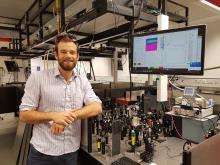Michael Price

2017: Dr Michael Price, Victoria University of Wellington, has been awarded Rutherford Foundation postdoctoral fellowship for research entitled: “Solar cells beyond the Shockley-Quiesser limit: 2-D semiconductors at the interface”
Photovoltaic solar panels convert light into electricity. This conversion is dependent on specific materials (semiconductors) with specific properties that allow light to excite electrons in the material, which generates electric power. A step change in photovoltaic technology – either in terms of device manufacturing or device efficiency - would go a long way towards stopping the worst impacts of climate change, and speeding the world’s transition to renewable energy. However, a current limitation in photovoltaics is the efficiency by which materials transform solar energy to electricity. This problem is captured in the “Schockley-Quiesser limit”, which states that for a single material solar cell, the maximum power efficiency is around 33 percent.
In this project, Dr Price will use cutting-edge equipment and methodologies developed at Victoria University of Wellington to try and further understand the photovoltaic properties of two exciting new semiconductor materials - metal halide perovskites and atomically thin transition metal dichalcogenides (TMDs). While metal halide perovskites have already shown a remarkable rise in their photovoltaic efficiency over the last few years from 3 to 22 percent, a really interesting property of both types of material is their potential to be suitable for an experimental type of solar cell termed “hot carrier cells”. A hot carrier solar cell would be able to beat the Shockley-Quiesser limit by harvesting energy from the high-energy part of the solar spectrum that is otherwise lost as heat in conventional solar cells, but they have proven too difficult to make due to a lack of suitable materials that can hold on to the thermal energy long enough for it to be harvested in the cell. By applying the spectroscopy equipment and expertise available at Victoria University to the perovskites and TMD materials, Dr Price aims to determine if the properties of the perovskites and TMD materials are suitable for hot carrier cells and, if so, work towards the realisation of actual hot carrier solar cell devices.
